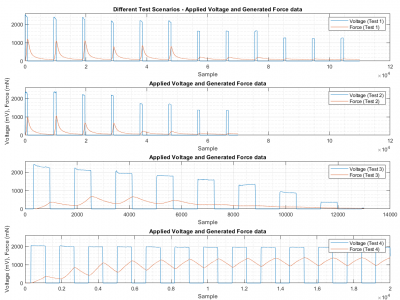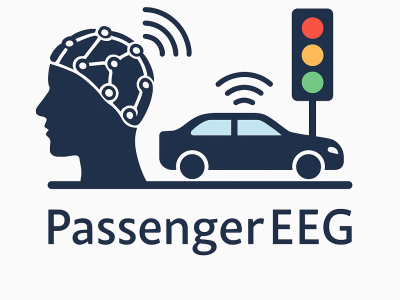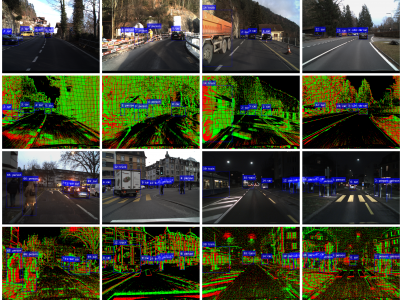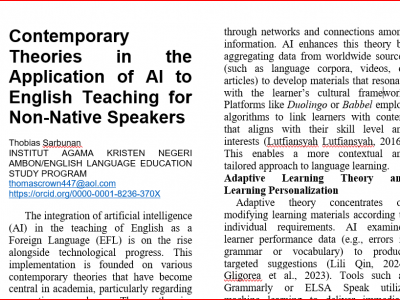Machine Learning

This study presents a deep learning-based framework for detecting vehicle deceleration patterns using Ultra-Wideband (UWB) Channel Impulse Response (CIR) analysis. Unlike traditional GPS or IMU-based systems, which struggle in GPS-denied environments such as tunnels, the proposed method leverages UWB CIR signal variations to classify two key driving behaviors: rapid deceleration and gradual deceleration. All data were collected from real-world experiments using UWB devices installed on actual vehicles at a professional highway testing site.
- Categories:
 3 Views
3 ViewsThe graph shows the force and voltage data obtained with the SMA Actuator System in four different scenarios. These scenarios were designed to capture the dynamic behavior according to the difference between the cooling times. The first two scenarios with long cooling times were used to examine the steady-state behavior, and the last two scenarios with short cooling times were used to examine the dynamic responses.
- Categories:
 3 Views
3 Views
This dataset provides packet traces captured in a realistic 5G Vehicle-to-Everything (5G-V2X) environment, encompassing both legitimate vehicular communications and Distributed Denial of Service (DDoS) attacks. By deploying four user equipments (UEs) under multiple attacker configurations, the collected captures reflect various DDoS types (TCP SYN, UDP, and mixed) and reveal their impact on 5G-V2X networks. The dataset is further enriched with Argus files and CSV feature tables, facilitating data-driven approaches such as Machine Learning (ML)-based detection agents.
- Categories:
 196 Views
196 ViewsAbstract
PassengerEEG is a brain-signal dataset designed to study how human passengers perceive and cognitively respond to potential traffic hazards in highly automated vehicles (AVs). As AVs increasingly replace human drivers, understanding passenger cognition becomes essential for improving vehicle safety and adaptive decision-making.
- Categories:
 30 Views
30 ViewsIntroduction
Welcome to the new challenging event-based multi-object tracking dataset (DSEC-MOT) repository. Our goal is to provide a challenging and diverse event-based MOT dataset with various real-world scenarios to facilitate the objective and comphrehensive evaluation of event-based multi-object tracking algorithms. This dataset, built upon DSEC, contains a variety of traffic entities and complex scenarios, aiming to address the current lack of event-based MOT datasets.
- Categories:
 32 Views
32 ViewsThe integration of artificial intelligence (AI) in the teaching of English as a Foreign Language (EFL) is on the rise alongside technological progress. This implementation is founded on various contemporary theories that have become central in academia, particularly regarding non-native speakers. These theories encompass sociocultural approaches, connectivism, and adaptive learning, which work in conjunction with AI’s capacity to tailor learning experiences and enhance language engagement.
- Categories:
 46 Views
46 ViewsThe integration of artificial intelligence (AI) in the teaching of English as a Foreign Language (EFL) is on the rise alongside technological progress. This implementation is founded on various contemporary theories that have become central in academia, particularly regarding non-native speakers. These theories encompass sociocultural approaches, connectivism, and adaptive learning, which work in conjunction with AI’s capacity to tailor learning experiences and enhance language engagement.
- Categories:
 19 Views
19 Views
This is a voiceprint dataset with speaker's normal voice and special voice.
We recruited user test participants by snowballing. We directly invited 34 participants, all of them are family members, friends and classmates of the authors, ranging in age from 16 to 55, with similar technical backgrounds. Next, the involved participants further invited their relatives and friends to join, then 21 additional participants joined our user study. Finally, 56 people participated in our user study.
- Categories:
 5 Views
5 Views
This is a voiceprint dataset with speaker's normal voice and special voice.
We recruited user test participants by snowballing. We directly invited 34 participants, all of them are family members, friends and classmates of the authors, ranging in age from 16 to 55, with similar technical backgrounds. Next, the involved participants further invited their relatives and friends to join, then 21 additional participants joined our user study. Finally, 56 people participated in our user study.
- Categories:
 5 Views
5 ViewsThe Lemon Leaf Disease Dataset (LLDD) is a high-quality image dataset designed for training and evaluating machine learning models for lemon leaf disease classification. The dataset contains 9 classes of images of healthy and diseased lemon leaves, such as; Anthracnose. Bacterial Blight, Citrus Canker, Curl Virus, Deficiency Leaf, Dry Leaf, Healthy Leaf, Sooty Mould, Spider Mites, making it suitable for tasks such as plant disease instance segmentation, detection, image classification, and deep learning applications in agriculture.
- Categories:
 146 Views
146 Views


